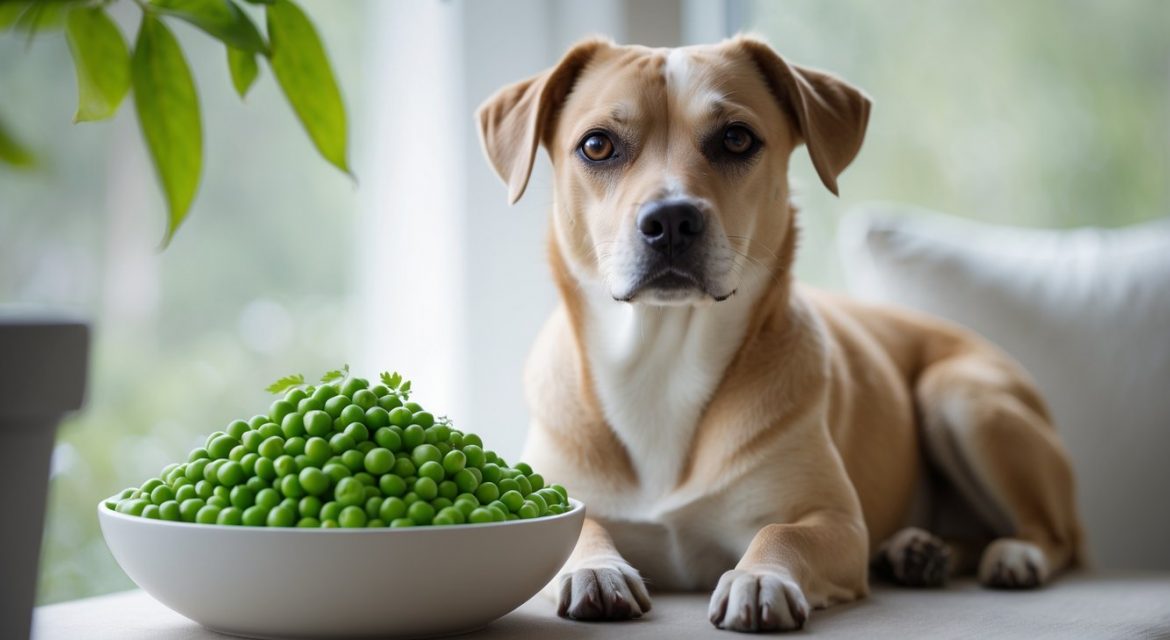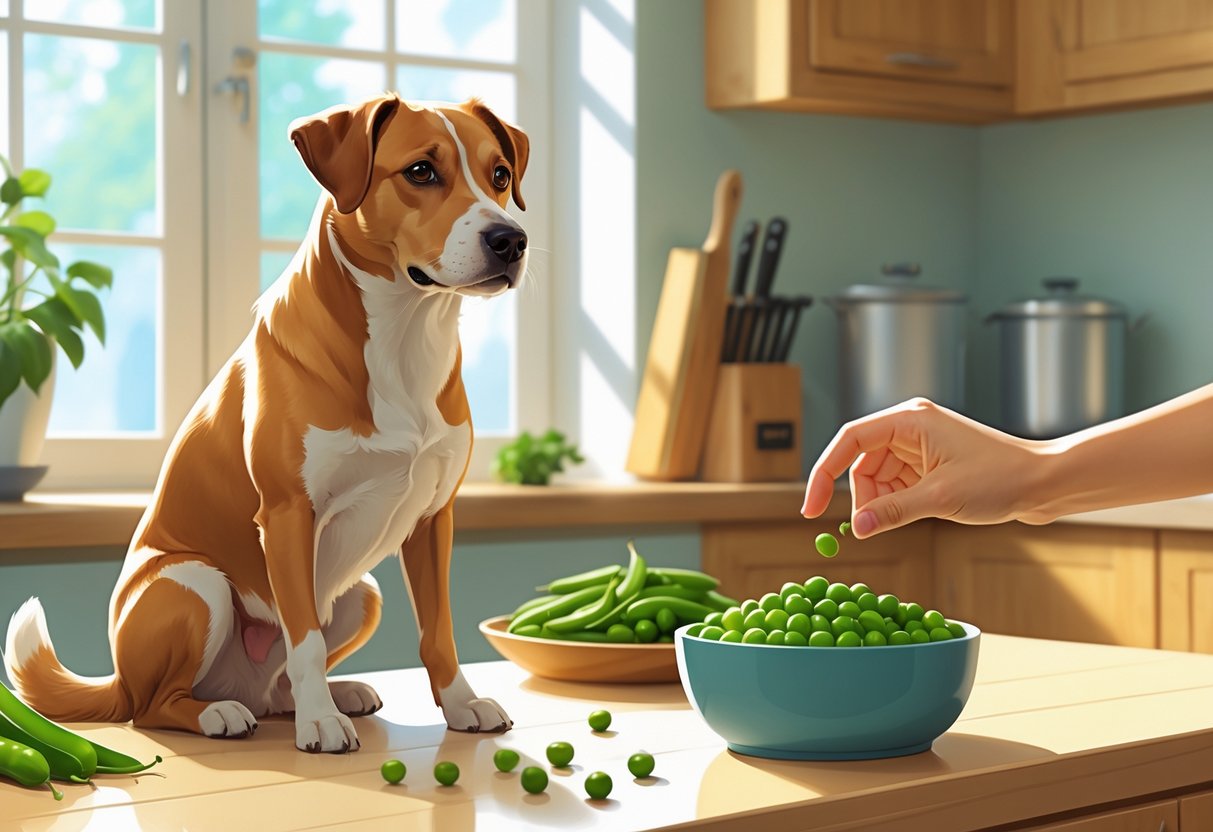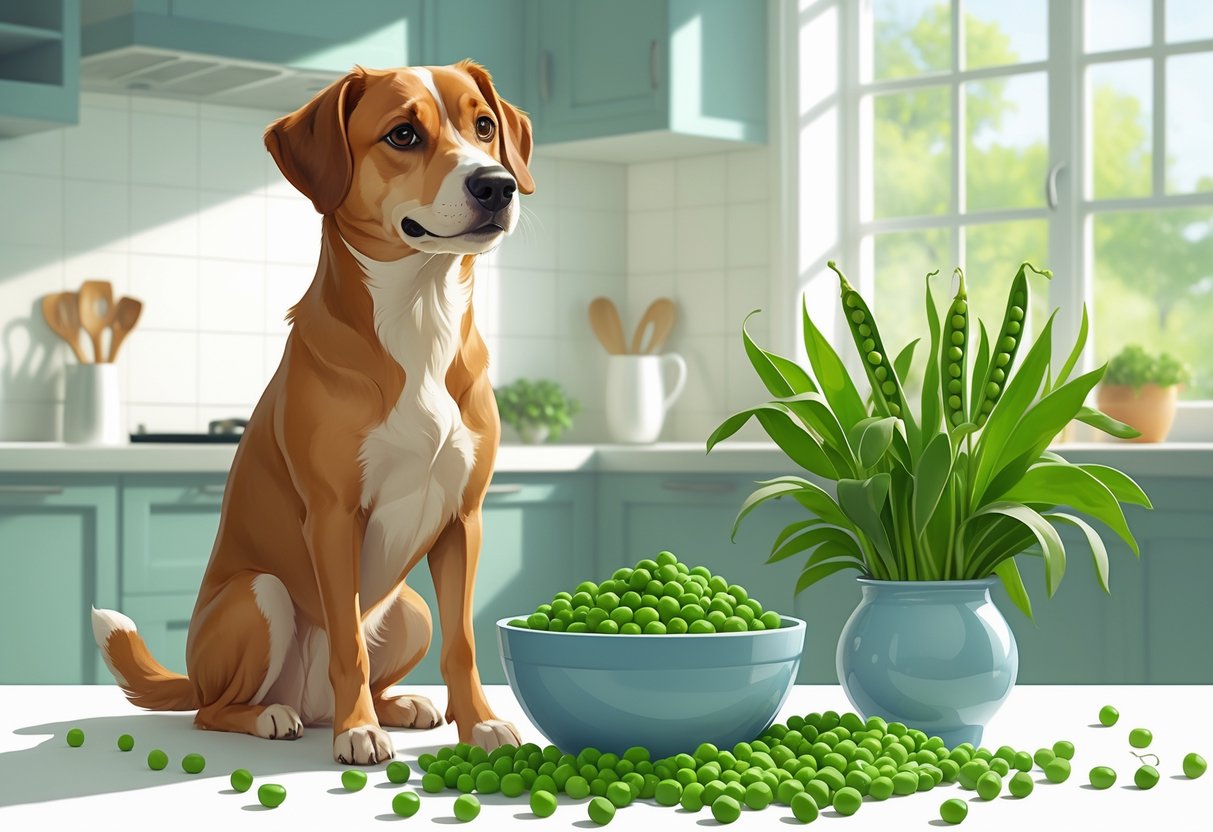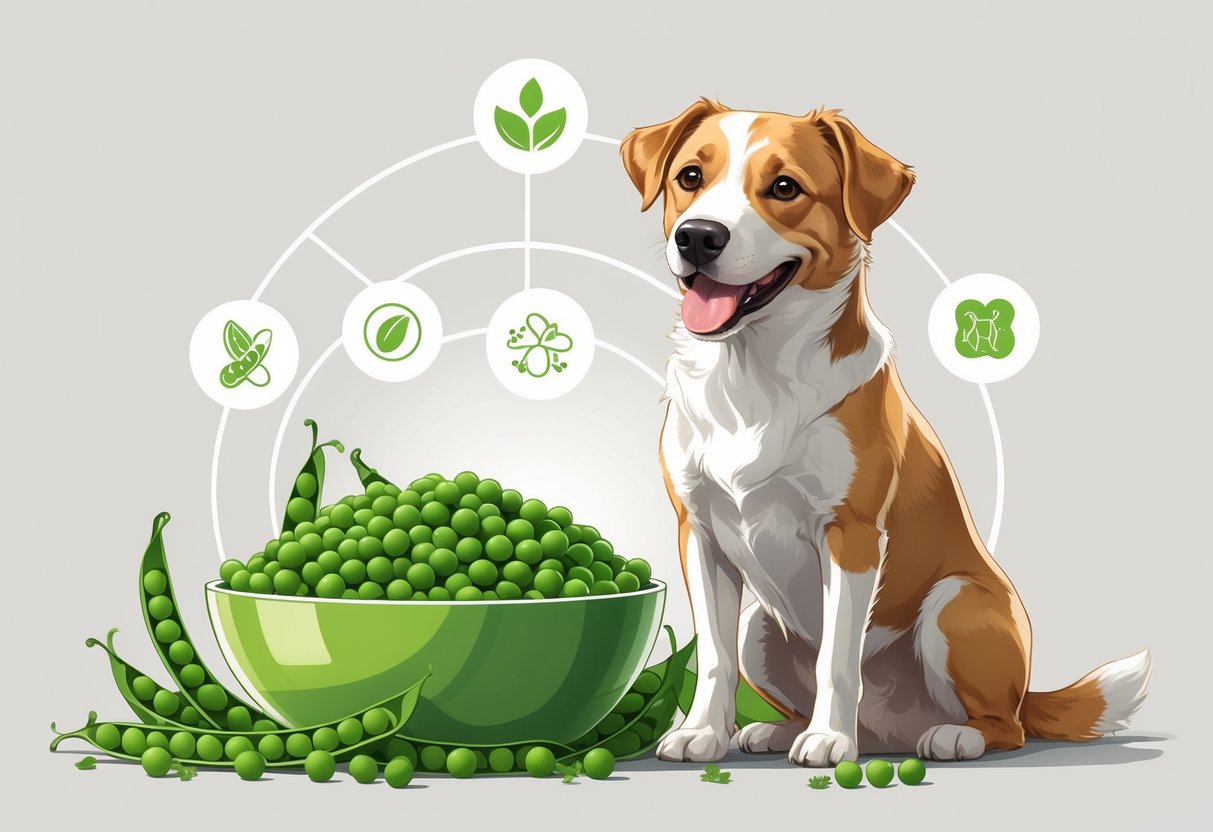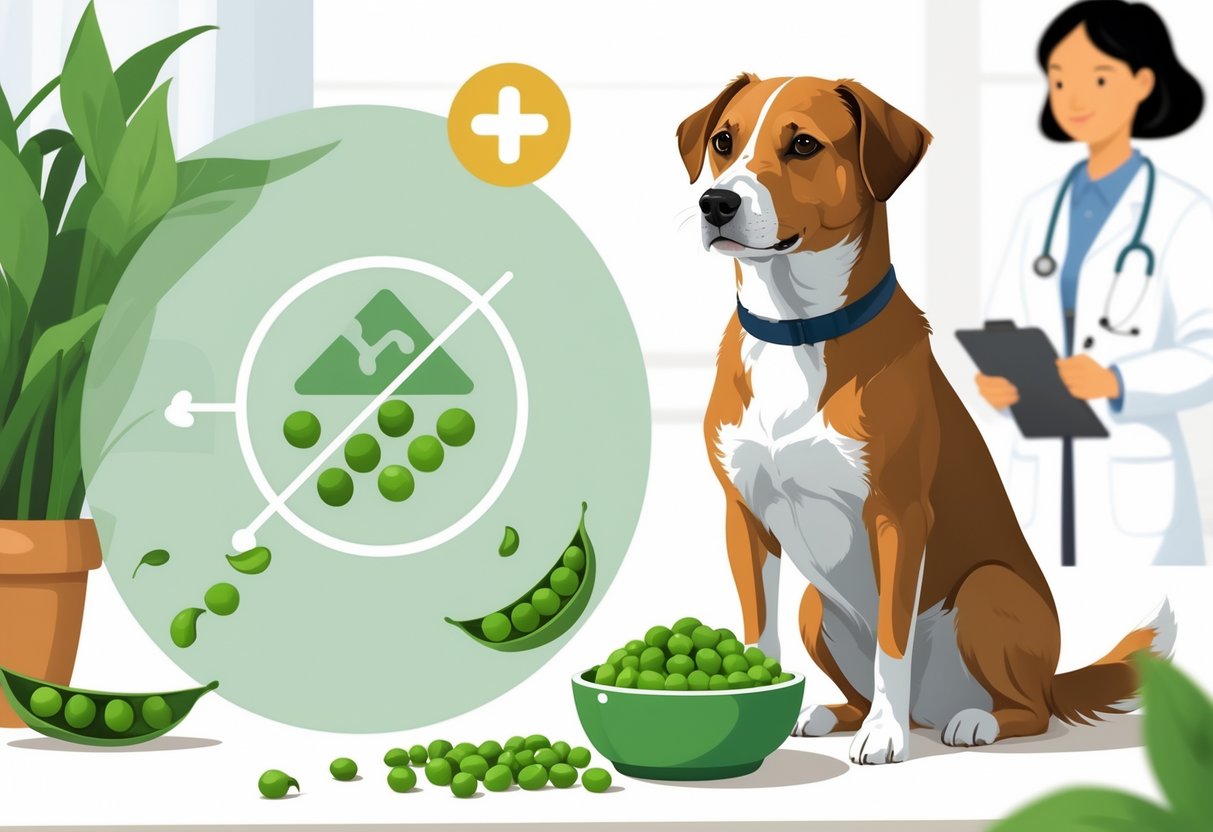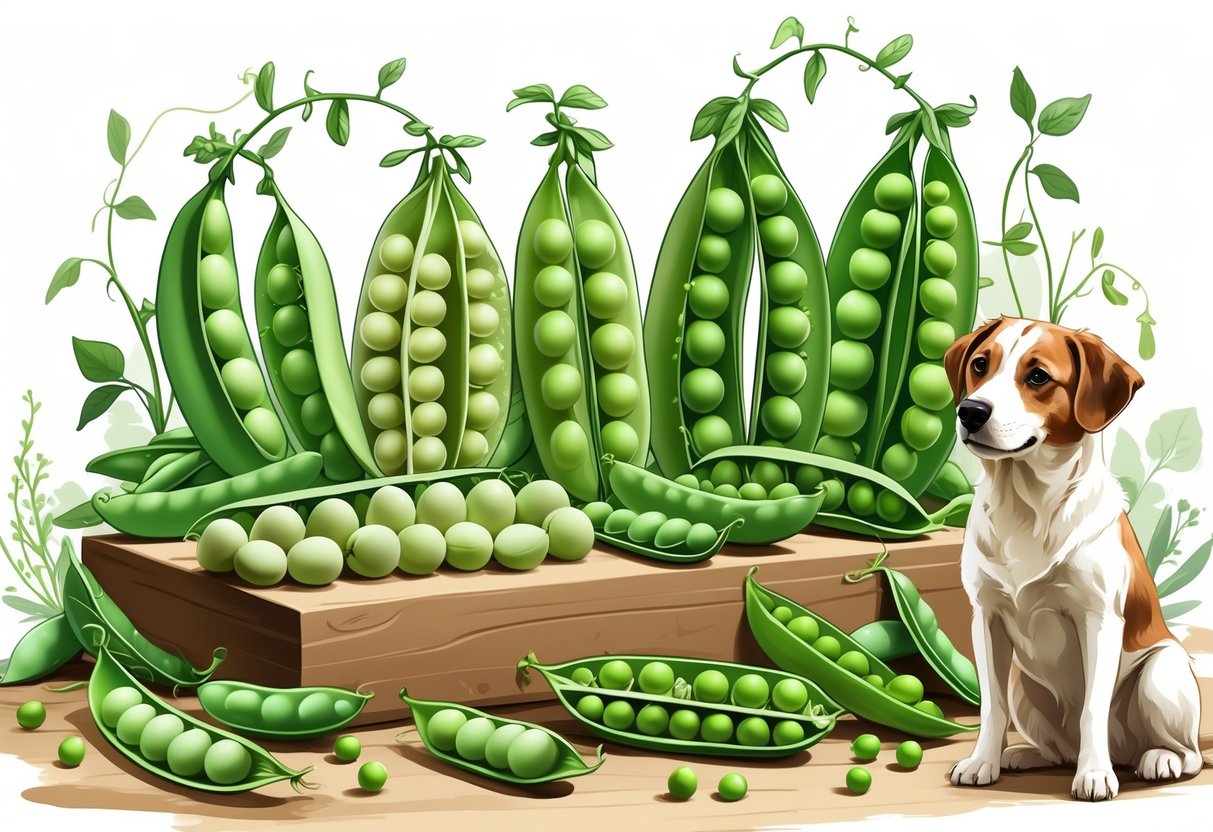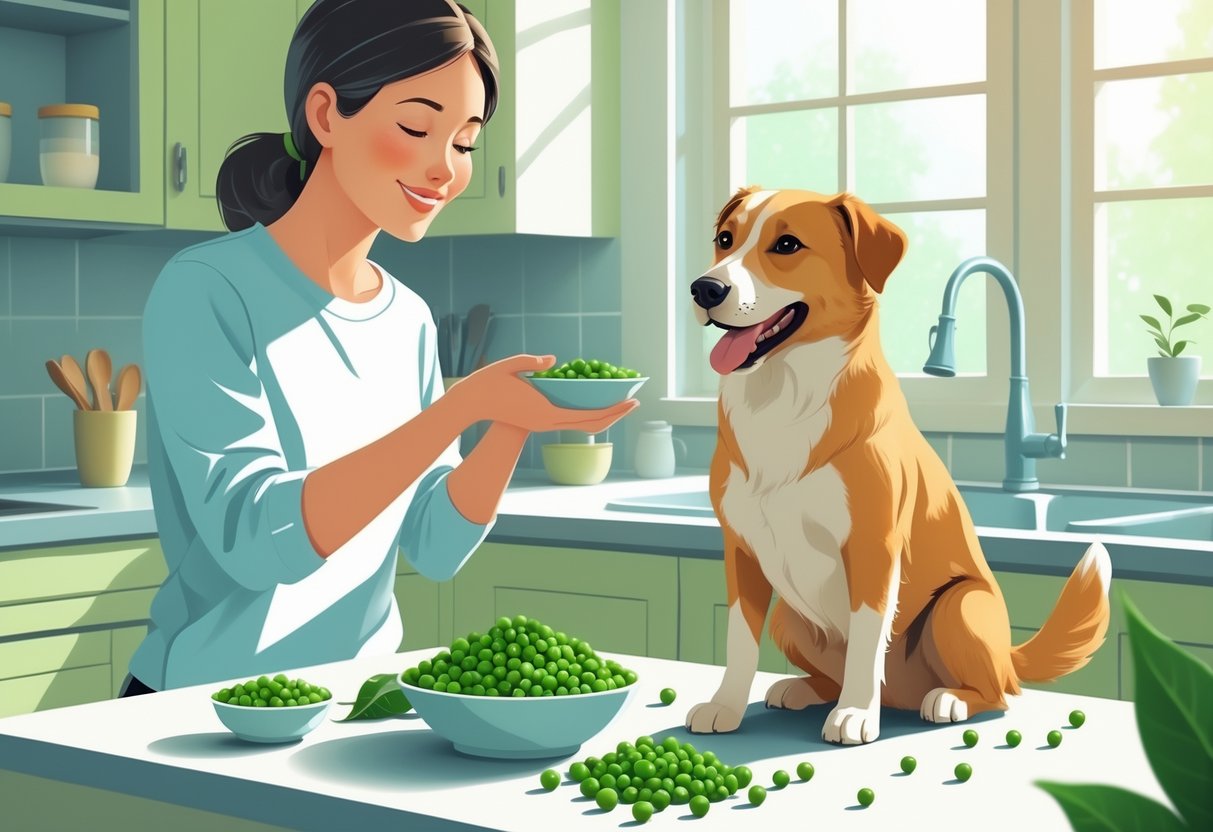Peas often show up on our dinner plates, so it’s only natural to wonder if you can share them with your dog. These little green veggies look innocent enough, but not every human snack is meant for a dog’s bowl.
Dogs can eat peas in moderation, as long as the peas are plain, cooked, and don’t have added salt or seasonings.
Peas offer your dog protein, fiber, and vitamins that help with energy and digestion. They work well as a treat or mixed into meals.
Not all peas are created equal, though. Canned peas usually have too much sodium, so fresh or frozen peas are the safer pick.
Knowing the right way to serve peas keeps your dog happy and healthy. It’s worth learning about the benefits and possible risks before tossing peas into your pup’s bowl.
Key Takeaways
- Dogs can eat plain, cooked peas in small amounts.
- Peas provide nutrients but shouldn’t replace balanced dog food.
- Skip canned peas. If you’re unsure about portions, check with your vet.
Can Dogs Eat Peas?
Peas can be a healthy snack for dogs if you serve them right. They’ve got nutrients that help with heart, eye, and immune health, but you’ll want to watch out for choking hazards and the extra salt found in canned peas.
Are Peas Safe for Dogs?
Peas are generally safe for dogs in small amounts. They bring vitamins A, B, and K, plus iron, potassium, and fiber, all good for energy and digestion.
Stick with fresh, frozen, or thawed peas. Canned peas usually have too much salt. The American Kennel Club warns that extra sodium can hurt your dog’s heart and kidneys.
If your dog has kidney problems, skip the peas. They contain purines, which can raise uric acid and make kidney issues worse. Always talk to your vet before adding new foods like peas to your dog’s diet.
Which Types of Peas Can Dogs Eat?
Dogs can eat green peas—that means snow peas, sugar snap peas, and garden peas—as long as they’re plain and not seasoned. These types have antioxidants that might help skin and heart health, according to The Vets.
Here’s a quick table to keep it straight:
| Type of Pea | Safe for Dogs? | Preparation Tips |
|---|---|---|
| Garden (English) peas | ✔ Yes | Remove from pod |
| Snow peas | ✔ Yes | Serve whole or chopped |
| Sugar snap peas | ✔ Yes | Serve fresh or frozen |
| Canned peas | ✖ No | Too much salt |
Only give pea pods if they’re soft and edible for humans. Hard pods can cause choking, especially in smaller dogs. Keep an eye on your dog while they’re eating peas.
How Much Peas Is Safe?
Don’t go overboard. A few teaspoons for a small dog or a few tablespoons for a big dog is plenty. Too many peas can cause stomach upset or gas.
Peas are best as a treat or mixed into meals—not as a main course. The Purina UK guide suggests using peas as a low-calorie snack rather than a daily habit.
If your dog gets bloated, vomits, or has diarrhea, stop giving peas and call your vet. Every dog is different, so it’s smart to introduce peas slowly and see how your pup reacts.
Nutritional Benefits of Peas for Dogs
Peas bring in nutrients that support your dog’s energy, digestion, and immune system. They have vitamins, minerals, plant-based protein, and antioxidants that help round out nutrition when used in moderation.
Vitamins and Minerals in Peas
Peas have vitamins A, B, C, and K plus minerals like iron, zinc, and potassium. These all play roles in keeping your dog’s vision, bones, blood, and muscles healthy.
Vitamin A supports eyesight and immune health. B vitamins help with energy and nerves. Vitamin C gives a light antioxidant boost, and vitamin K helps with blood clotting.
Minerals matter, too. Iron helps make red blood cells, zinc keeps the skin and coat in good shape, and potassium supports the heart and muscles. According to Dog Food Guides, green peas are especially rich in potassium and B vitamins, making them a smart add-on for many dogs.
Protein and Fibre Content
Peas give a modest boost of plant-based protein. Dogs mainly need animal protein, but a little extra from peas can help with muscle tone and recovery after play.
They also offer dietary fiber, which helps digestion and keeps things moving. Fiber can help dogs feel fuller, which is handy for those who need to watch their weight.
Peas are easy to mix into dog food. You can mash or lightly steam them to make them easier to digest, especially for small breeds. As pointed out by The Canine Nutritionist, peas can help boost energy when they’re part of a balanced diet.
Antioxidants and Their Role
Peas naturally have antioxidants like lutein and polyphenols. These help protect your dog’s cells from oxidative stress, which can play a role in aging and inflammation.
Antioxidants support the immune system and may help with long-term heart and eye health. Lutein is especially good for vision and skin, while polyphenols may help soothe mild inflammation.
Giving peas as an occasional treat gives your dog a little antioxidant support without extra supplements. According to The Vets, these nutrients help maintain cell health and go well with a diet rich in fresh veggies.
Potential Risks and Health Considerations
Peas can be a healthy treat for lots of dogs, but they’re not right for every pup. Some dogs struggle to digest them. Others need to skip peas because of kidney or heart issues.
Dogs with Kidney Issues
Dogs with kidney problems should avoid peas. Peas have purines, which break down into uric acid and can make kidney disease or urate bladder stones worse.
Vets often say to limit purine-rich foods for dogs with kidney issues. This means peas, lentils, and some meats. Feeding peas to these dogs adds stress to their kidneys and makes it harder to filter waste.
Always talk to your veterinarian before adding peas to the diet of a dog with kidney concerns. Even a little bit can be risky for dogs with kidney trouble. Try lower-purine veggies like carrots or green beans instead.
Digestive Upset and Allergies
Some dogs might get gas, bloating, or diarrhea after eating peas, especially if they eat too many or have sensitive stomachs.
Very occasionally, dogs can be sensitive or allergic to peas. You might notice itchy skin, ear infections, or stomach issues. If you spot these, stop the peas and call your vet.
To keep things easy on the stomach, always serve peas plain and unseasoned. Avoid canned peas with salt. Fresh or frozen peas are gentler and easier to portion. For more prep tips, check out this vet-reviewed guide.
Peas and Heart Health in Dogs
There’s been talk about peas in grain-free diets possibly linking to dilated cardiomyopathy (DCM), a heart problem that weakens the muscle. The FDA looked into it, but there’s no solid proof that peas alone cause DCM.
Most experts think the issue is with some grain-free commercial dog foods that use too many peas or lentils and miss out on nutrients like taurine, which is important for the heart.
Giving your dog a few peas as a treat isn’t the same as feeding a pea-heavy diet. If you stick with balanced foods from trusted brands, heart risks are unlikely. You can read up on this in Can Dogs Eat Peas? A Vet-Reviewed Guide for 2025.
Types of Peas and How They Differ
Peas come in quite a few varieties, each with its own texture and flavor. Some are great fresh or frozen, while others need extra care thanks to tough pods or added salt in canned versions.
Knowing these differences helps pet owners pick the safest, most nutritious peas for their dogs. It’s not always obvious which type is best, but a little info goes a long way.
Green Peas and Garden Peas
Green peas—sometimes called garden peas—are the ones you’ll find most often at home. They’re small, sweet, and packed with vitamins A, K, and B.
Serve them plain, cooked, or thawed from frozen. Most dogs do fine with these, but if you use canned peas, watch out for added salt.
Fresh or frozen peas keep their nutrients and go easy on a dog’s stomach. Canned peas, though, usually have too much sodium. If you must use canned, choose no-salt or low-sodium options and rinse them well.
Garden peas also offer fiber for healthy digestion and weight. You can toss them into regular food or use them as training treats. According to The Beloved Dog, fresh or frozen green peas are usually your best bet.
Sugar Snap Peas and Snap Peas
Sugar snap peas (just called snap peas sometimes) have crisp, edible pods and a hint of sweetness. Dogs love their crunch, but cut them into bite-sized pieces to avoid choking.
Raw or lightly steamed snap peas both work. Cooking softens the pods and makes them easier to digest. Skip the butter, salt, and seasonings—dogs don’t need those.
Snap peas bring fiber, plant protein, and antioxidants to the table. They support digestion and the immune system. Always check that the pods are tender, not stringy, especially for smaller dogs. PetMD says snap peas are safe if served plain and in moderation.
Snow Peas and English Peas
Snow peas have flat, edible pods and a mild flavor. Most dogs can chew and digest them easily, whether raw or lightly steamed.
English peas look like garden peas but usually come in inedible pods. Only the inner peas should be fed to dogs—the pods are tough and can be a choking risk.
Both snow and English peas offer vitamins A and K, plus minerals like potassium and magnesium. Serve them plain and properly prepared for a safe, low-calorie snack. The Dog Food Guides site points out that unsalted, unseasoned peas are healthiest for dogs.
Serving Peas to Your Dog Safely
Feeding peas can be a healthy choice for dogs, but it depends on how you prepare them. What you mix them with and the type of food matters, too.
Best Ways to Prepare Peas
Dogs can eat peas that are fresh, frozen, or cooked. Lightly boiling or steaming keeps nutrients while making them easier to digest.
Raw peas are fine but can be harder to process for some dogs. Skip seasonings, butter, and oils—they just add fat and salt.
The Canine Nutritionist recommends avoiding tinned peas because of the sodium. When serving, mix peas into meals or use as treats. A spoonful or two is plenty for most dogs.
Too many peas can cause gas or tummy upset. Moderation is key.
| Type of Pea | Safe for Dogs | Preparation Tip |
|---|---|---|
| Garden Peas | ✔ | Steam or boil; remove shells |
| Sugar Snap Peas | ✔ | Serve raw or steamed |
| Canned Peas | ✖ | Too much sodium |
| Split Peas | ✔ | Cook before serving |
Peas in Commercial Dog Food
Lots of commercial dog foods use peas for plant protein and fiber. They help balance nutrients and aid digestion.
Brands often swap out grains like rice or corn for peas in grain-free recipes. Peas provide vitamins A, K, and B, plus iron and zinc. These support immune health and muscle function.
Some studies hint that too many peas in grain-free foods might connect to heart issues. Pet owners should check ingredient lists and pick foods where peas aren’t the main filler.
If you’re not sure, ask your vet whether a pea-based food is right for your dog.
Foods and Additives to Avoid
Some foods just don’t mix well with peas. Tinned peas often have salt and preservatives—skip those.
Keep onions, garlic, and heavy sauces off your dog’s plate. They can mess with digestion and cause real harm.
Artificial flavors, added sugar, and fatty toppings can also upset a dog’s stomach. PetMD says plain peas in small amounts are a healthy addition to a balanced diet.
If your dog has kidney problems, peas might not be a good fit. They contain purines, which raise uric acid. In those cases, skip peas and talk to your vet about alternatives.
When to Consult Your Vet
Most dogs can eat peas without trouble, but every pup’s different. Watch for changes in behavior, digestion, or appetite after feeding new foods.
If something seems off, a veterinarian can help sort out symptoms and keep your dog’s diet on track.
Recognising Adverse Reactions
Some dogs react poorly to peas, even if it’s rare. You might see vomiting, diarrhea, gas, or itching.
If you notice these, stop feeding peas and call your vet. Allergic dogs might also get skin irritation or swelling around their face or paws. This can happen even if they’ve eaten peas before without an issue.
Vet Explains Pets says legume allergies are uncommon, but you never know. Tracking what you feed and any symptoms can help your vet find the cause faster.
Special Dietary Needs
Some dogs need extra care with their food. Dogs with diabetes, kidney disease, or food allergies should get tailored advice before trying peas.
Peas have natural sugars and plant proteins, which don’t work for every dog. The American Kennel Club (AKC) warns that dogs with certain heart issues should avoid grain-free, legume-heavy diets.
There’s talk about a possible link between these diets and dilated cardiomyopathy (DCM), but honestly, more research is needed. Always avoid peas mixed with salt, butter, garlic, or onions—those ingredients can be dangerous.
If you’re unsure, stick to plain cooked peas and check with your vet about what’s best for your dog.
Seeking Professional Advice
When adding new foods, your vet really is your best resource. They’ll look at your dog’s weight, age, and activity level to figure out safe amounts.
For dogs on prescription diets, even little changes can throw things off. Check with your vet so peas don’t interfere with medications or existing plans.
If peas cause trouble or your dog’s diet already covers fiber and vitamins, your vet might suggest skipping them. The Vets recommends introducing new foods slowly and keeping an eye on your dog’s reaction.
Frequently Asked Questions
Peas can be a healthy treat for dogs if you serve them right. They’ve got good nutrients, but the way you prepare them and your dog’s health make all the difference.
Are peas a safe treat for your furry friend?
Yes, peas are usually safe for dogs in moderation. Canine Bible says fresh or frozen peas without salt or seasoning are best. Canned peas have too much sodium and can strain a dog’s heart and kidneys.
What benefits do peas offer to our canine companions?
Peas bring plant-based protein, vitamins A, K, and B, plus minerals like iron and potassium. These help muscles, the immune system, and digestion. The guide by The Vets calls peas a low-calorie, nutrient-packed snack when served right.
How often should we include peas in our dog’s diet?
Keep peas as a small part of your dog’s meals. Treats—including peas—shouldn’t be more than 10% of daily food. Once or twice a week in small amounts is plenty for most dogs.
Could some dogs have adverse reactions to eating peas?
Some dogs get gas, bloating, or diarrhea from too many peas. Dogs with kidney issues or those prone to urate stones (like Dalmatians) should avoid peas because of purines. If your dog seems uncomfortable, call your vet.
What’s the best way to prepare peas for your pooch?
Lightly cooked or steamed peas are easiest on digestion and keep most nutrients. Always serve them plain—no salt, butter, or seasonings. PetsCare suggests washing raw peas well to remove pesticides.
Are there any types of peas that should be avoided in doggy meals?
I’d steer clear of canned peas with added salt or preservatives. Those just aren’t great for pups.
Hard pea pods, like the ones from garden peas, can be a choking hazard. It’s just not worth the risk.
Split peas are fine if you cook them, but if you go overboard, they can make your dog gassy. Not exactly pleasant for anyone.
Soft, fresh, or frozen peas are usually the safest bet for most dogs. Simple and easy—just how I like it.


